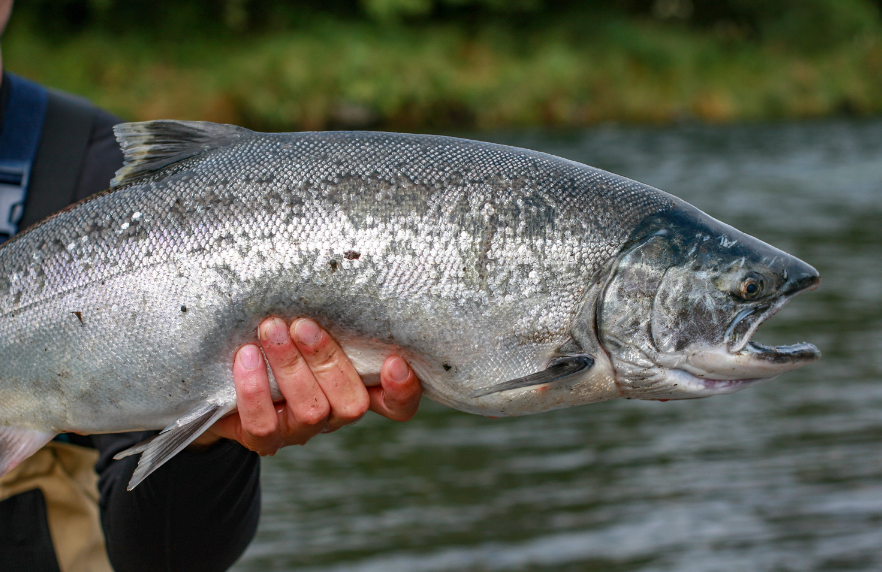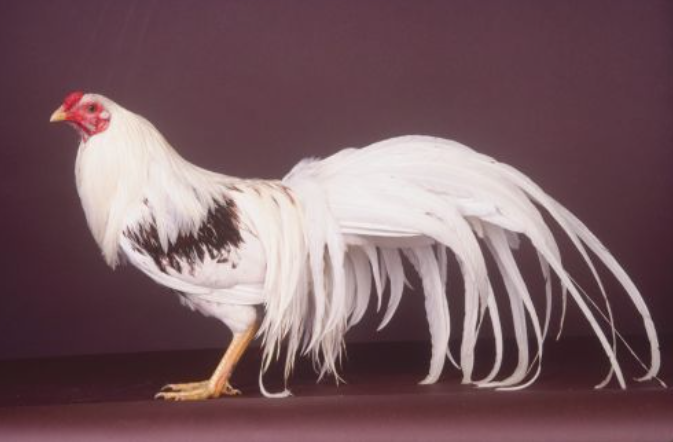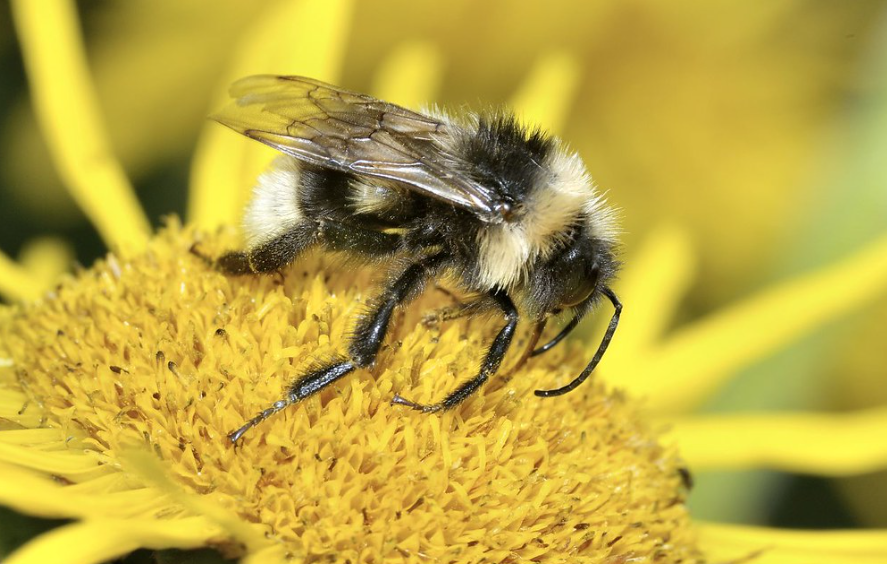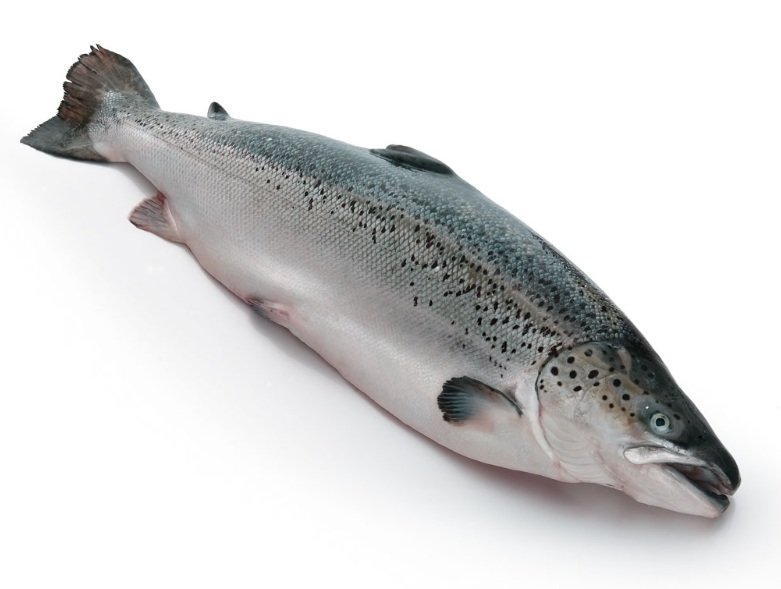
Quick Top 10 Facts about Steelhead Salmon
| SCIENTIFIC NAME | Oncorhynchus mykiss |
| CLASSIFICATION | KINGDOM: Animalia PHYLUM: Chordata CLASS: Actinopterygii ORDER: Salmoniformes FAMILY: Salmonidae GENUS: Oncorhynchus SPECIES: O. mykiss |
| SIZE | Length: 20–45 inches (50–115 cm) Weight: 5–40 pounds (2.3–18 kg) |
| HABITAT | Cold, clean rivers, streams, and the ocean; native to the Pacific Ocean and connected freshwater systems in North America and Asia |
| DIET | Carnivorous; eats insects, crustaceans, and smaller fish |
| SPECIES | Steelhead Trout (anadromous form of the Rainbow Trout) |
| COUNTRY | Native to North America’s Pacific Coast and parts of Asia |
| GESTATION PERIOD | Spawns in freshwater; eggs hatch after 3–4 weeks depending on temperature |
| LIFE SPAN | 4–6 years on average |
| CONSERVATION STATUS | Varies by population; some are considered threatened or endangered due to habitat loss, pollution, and overfishing |
Amazing Facts About Steelhead Salmon
1. They are rainbow trout that go to the ocean
Steelhead Salmon are actually a migratory form of Rainbow Trout that live in the ocean and return to freshwater to spawn.
2. They are anadromous
This means they are born in freshwater, migrate to the ocean to grow, and return to freshwater rivers to reproduce.
3. They can spawn multiple times
Unlike Pacific salmon, Steelhead can survive spawning and return to the ocean, sometimes spawning more than once in their lifetime.
4. They are powerful swimmers
Steelhead are known for their incredible strength and speed, which makes them a favorite among sport anglers.
5. Their diet changes with age
Juveniles eat mostly insects and zooplankton, while adults prey on squid, shrimp, and smaller fish.
6. They exhibit diverse behaviors
Some Steelhead spend only a year in the ocean, while others may remain for up to three years before returning to spawn.
7. They are sensitive to environmental changes
Steelhead require clean, cold water and are often used as indicators of healthy river ecosystems.
8. They show homing behavior
Like salmon, Steelhead return to the exact stream where they were born to spawn, often traveling hundreds of miles.
9. They have a silvery body with a pink stripe
Steelhead can be identified by their streamlined shape and the faint pink to red stripe running along their sides.
10. Conservation efforts are underway
Due to population declines, Steelhead are the focus of conservation programs that aim to restore habitats and regulate fishing practices.
Top 10 Intriguing facts about Steelhead salmon
Oncorhynchus mykiss, which is also known as steelhead salmon, is a very popular game fish that hunters all over the world love for its tasty meat and amazing fighting skills. Although it comes from the Pacific side of North America, this species can swim back and forth between rivers and lakes in Europe and Asia. It belongs to the Salmonidae family. Steelhead salmon, which can travel hundreds of kilometers upstream to place their eggs in gravelly riverbeds, exhibit remarkable breeding movements. Because steelhead salmon are big and have a shiny color, fishing for them has become more popular as a hobby.
People who like to fish often go to well-known spots like the Fraser River in British Columbia and the Columbia River in the Pacific Northwest. To hook these valuable specimens, hunters use a variety of methods, including drift fishing, fly fishing, and spin casting. Furthermore, breeding operations and protection efforts are important to keeping healthy populations of steelhead salmon in the face of natural challenges and ecosystem decline.
Origin and habitat of Steelhead Salmon fish
Native to North America, steelhead salmon, commonly called rainbow trout, are anadromous fish species. They are distinguished by their distinctive silvery color and ability to transition between fresh and saltwater environments. Steelhead salmon are popular among sport fishermen due to their delectable flavor and strength.
Traits and Behaviors of Steelhead Salmon fish
These fish, which can jump out of the water and swim great distances, are renowned for their extraordinary power and agility. Usually, steelhead salmon deposit their eggs on gravel beds in freshwater rivers and streams where they spawn. The baby salmon will spend a few years in freshwater after hatching before making their way to the ocean, where they will develop and mature before mating in their original streams.
Ecological Importance of Steelhead Salmon fish
Because steelhead salmon are an essential food supply for many predators, including eagles, bears, and other fish species, they are vital to the ecology. In addition, they support the health of both ecosystems by moving nutrients from freshwater to saltwater. Conservation efforts are being made to safeguard and restore the declining steelhead salmon populations in recent years, which are a result of overfishing and habitat damage.
Insights into the Fascinating Steelhead Salmon Fish
Steelhead salmon are amazing animals with a distinctive life cycle and extraordinary adaptability. These are amazing animals that should be admired and preserved because of their capacity for long-distance travel, environmental adaptation, and exciting fishing experiences. By comprehending and valuing these intriguing details of steelhead salmon, we may help to protect and maintain their existence in our rivers and seas.
Anadromous Life Cycle of Steelhead Salmon fish
The anadromous life cycle of steelhead fish is one of its most fascinating characteristics. In contrast to other salmon species, steelhead spend a large part of their lives in the ocean after migrating from the freshwater streams and rivers where they were born. They return to their birthplace to procreate after spending many years at sea. It’s quite amazing how nomadic this habit is. In order to return to their natal streams, steelhead must navigate through intricate ocean currents and barriers across distances of hundreds or even thousands of kilometers.
Adaptability and Flexibility of Steelhead Salmon fish
The capacity of steelhead salmon to adapt to a variety of habitats is well known. They are distinct from other salmon species in that they can live in both freshwater and saltwater environments. Because of their flexibility, steelhead may be found in a variety of environments, including lakes, big rivers, and tiny mountain streams. In addition, steelhead can tolerate a wide range of water temperatures, from chilly alpine streams to warmer coastal waters. Because of their versatility, they are very hardy and capable of surviving in a variety of environments.
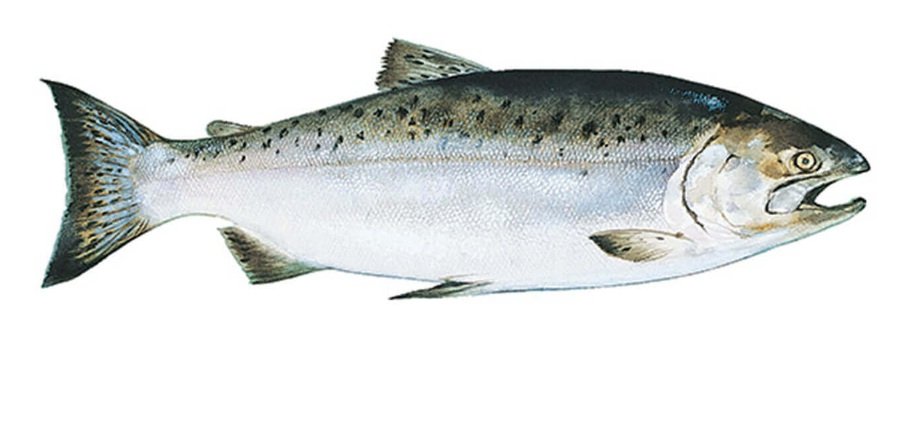 Physical Characteristics for Steelhead Salmon fish
Physical Characteristics for Steelhead Salmon fish
Salmon steelheads are renowned for their enormous size. Adult steelhead typically weigh between 8 and 20 pounds and reach lengths of 24 to 40 inches. But others have been known to grow considerably bigger; stories exist of steelheads that weigh more than thirty pounds.
These fish can move quickly through the water because of their sleek bodies. Their backs and sides are colored silver, which helps them blend in with their environment and protects them from predators.
Feeding Patterns for Steelhead Salmon fish
Steelhead salmon eat a variety of foods and are opportunistic eaters. They mostly consume insects, larvae, and tiny crustaceans that are present in freshwater streams during the early stages of their lives. Their food diversifies as they become bigger and travel to the ocean, including shrimp, squid, and small fish.
Recreational Fishing and Threats for Steelhead Salmon fish
Anglers worldwide are enamored with steelhead salmon because of their remarkable fighting power and size. They are an exciting catch for both beginning and seasoned fishermen because of their remarkable jumps and strong runs. Steelhead populations, however, are under strain because of the popularity of the sport, particularly in regions where overfishing and habitat destruction have taken place.
Conservation programs for Steelhead salmon fish
Thus, several conservation initiatives are being carried out to preserve and replenish steelhead stocks. These initiatives include monitoring spawning areas, fishing restrictions, and habitat restoration programs. We can guarantee this amazing species’ long-term existence by enacting sustainable fishing methods and protecting their natural habitats.
FAQ (Frequently Asked Questions) about Steelhead Salmon
Q: What is a Steelhead Salmon?
Ans: Steelhead Salmon (Oncorhynchus mykiss) are a sea-run form of the Rainbow Trout. Unlike regular Rainbow Trout, Steelhead migrate from freshwater rivers to the ocean and return to freshwater to spawn. They are known for their incredible strength, silvery appearance, and are popular among anglers and conservationists alike.
Q: Where does the Steelhead Salmon live?
Ans: Steelhead are native to the Pacific Ocean and the rivers and streams that flow into it, especially in North America—from California up to Alaska and into parts of Russia. They spend part of their lives in the ocean and return to freshwater rivers and streams to spawn. Some populations have adapted to stay entirely in freshwater systems.
Q: What does the Steelhead Salmon look like?
Ans: Steelhead have a sleek, silvery body with a bluish-green tint on the back and a white belly. During spawning season, they may develop a pink to red stripe along their sides, similar to Rainbow Trout. They also have small black spots on their back, dorsal fin, and tail.
Q: How big does the Steelhead Salmon get?
Ans: Steelhead Salmon can grow quite large, typically ranging from 24 to 36 inches (61 to 91 cm) in length and weighing between 8 to 20 pounds (3.6 to 9 kg). However, some individuals can grow much larger depending on environmental conditions and food availability.
Q: What does the Steelhead Salmon eat?
Ans: While in freshwater, young Steelhead eat aquatic insects, larvae, and small crustaceans. Once they migrate to the ocean, they feed on a diet of fish, squid, and other marine organisms. Their diverse diet helps them grow rapidly during their ocean phase.
Q: How long do Steelhead Salmon live?
Ans: Steelhead typically live 4 to 6 years. Unlike many other Pacific salmon species, Steelhead can survive spawning and return to the ocean to spawn again, though many only spawn once. This unique life cycle trait adds complexity to their management and conservation.
Q: Are Steelhead Salmon endangered?
Ans: Some populations of Steelhead are listed as threatened or endangered under the U.S. Endangered Species Act due to habitat loss, overfishing, dams, and pollution. Conservation efforts are ongoing to restore their habitats, improve fish passage, and manage fisheries sustainably.
Q: Can you eat Steelhead Salmon?
Ans: Yes, Steelhead Salmon is a popular fish for consumption. It is known for its mild, slightly sweet flavor and firm texture. Steelhead is rich in omega-3 fatty acids and is considered a healthy protein choice. Both wild-caught and farm-raised Steelhead are available in markets.
Q: How is the Steelhead Salmon different from Rainbow Trout?
Ans: Steelhead and Rainbow Trout are the same species, but Steelhead are anadromous, meaning they migrate to the ocean and return to freshwater to spawn. In contrast, Rainbow Trout typically live their entire lives in freshwater. This difference in lifestyle leads to variations in size, coloration, and behavior.
Q: Why are Steelhead important?
Ans: Steelhead Salmon play a key role in aquatic ecosystems and are important indicators of river health. They are also culturally significant to Indigenous communities and are a valuable species for recreational and commercial fishing. Their life cycle helps transfer marine nutrients into freshwater ecosystems, benefiting other wildlife.
#SteelheadSalmon, #OncorhynchusMykiss, #RainbowTrout, #AnadromousFish, #SalmonFacts, #FishConservation, #Wildlife, #FreshwaterFish, #AnglersLife, #PacificSalmon, #HealthyEcosystems, #SustainableFishing
Our sources and references about Steelhead Salmon
1: Wikipedia – Steelhead Trout
2: NOAA Fisheries – Steelhead Trout
3: USDA Forest Service – Steelhead Trout
4: National Wildlife Federation – Steelhead Trout
